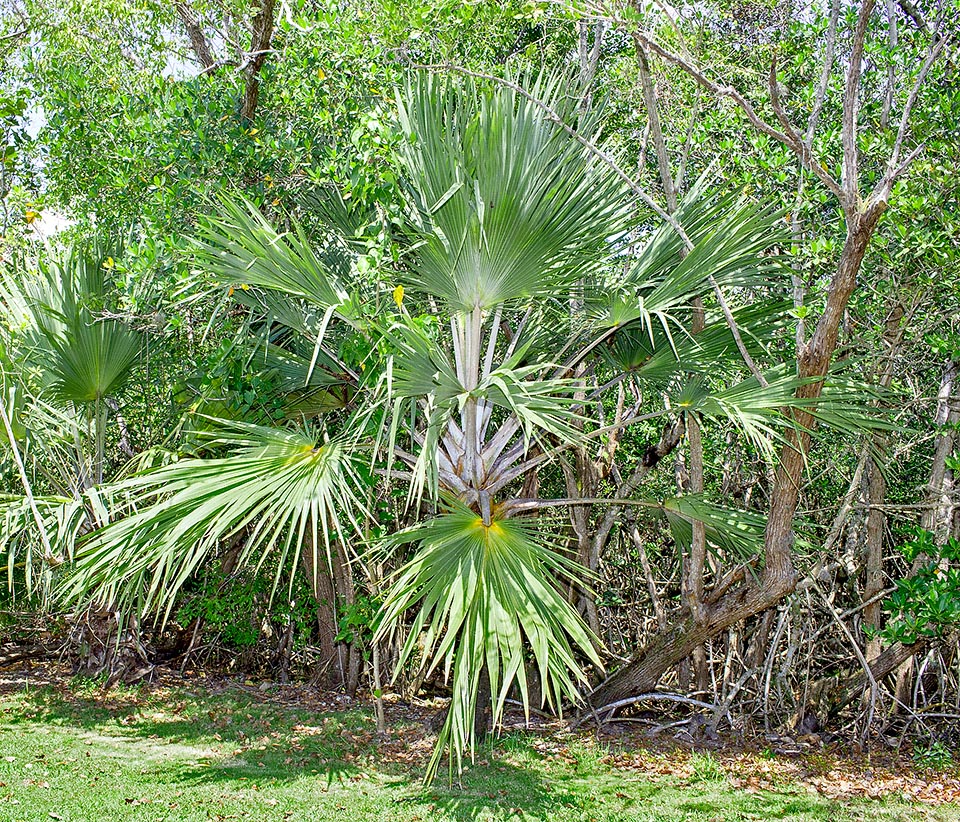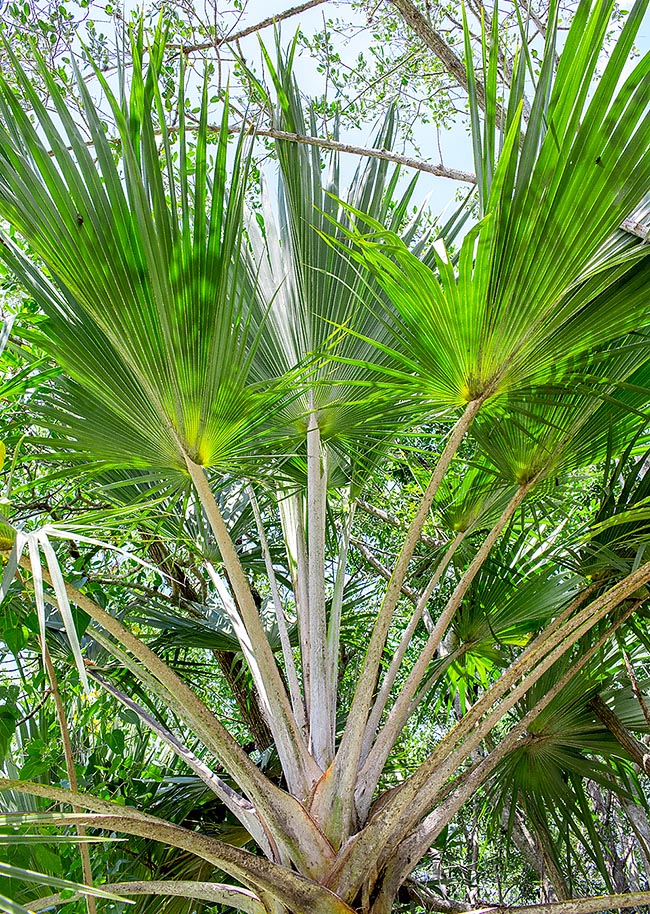Family : Arecaceae

Text © Pietro Puccio

English translation by Mario Beltramini

At very high risk of extinction in nature, the Latania verschaffeltii is a dioecious species endemic to Rodrigues Island, the smallest of the Mascarenhas © Giuseppe Mazza
The species is endemic to Rodrigues (Mauritius) where is present a residual population, with a limited number of individuals, in a valley in the northern zone of the island close to the coast.
The generic name comes from the French corruption, latanier, of the native name; the species is honored to the Belgian horticulturist Ambroise Colette Alexandre Verschaffelt (1825-1886) who was the first to introduce it in Europe.
Common names: yellow latan, yellow rattan palm (English); latanier, latanier de Rodrigues, Latanier jaune (Rodrigues).
The Latania verschaffeltii Lem. (1859) is a dioecious species with solitary stem, erect, wrinkled and greyish, with the elliptical traces of the junction of the fallen leaves spirally arranged, up to 15 m tall, in the oldest specimens in nature, and of 25-30 cm of diameter, slightly dilated at the base.

In the young plants the petiole, the veins and the edges of the segments have a bright yellow orange colour © Giuseppe Mazza
The leaves, on a 1,2-1,8 m long petiole, are costapalmate, 1,5-1,8 m long, subdivided in lanceolate segments with acuminate apex, 60-90 cm long and 5-8 cm broad, united at the base per about half or little less of their length, of pale green colour.
In the young plants petiole, veins and margins of the segments have a bright orange yellow colour, in the adult ones the petiole is covered by a thick woolly tomentum of greyish white colour.
Male and female inflorescences on different individuals, between the leaves (interfoliar), 1,2-1,8 m long, with ramifications of second order, the male with 5-15 rachillae of various length at the apex of the primary ramifications and sunken flowers, about 0,6 cm long, with 26-32 stamina. Female inflorescences with 2-3 rachillae at the apex of the primary ramifications with globose flowers of about 1 cm of diameter. The fruits are obovate drupes greenish brown when ripe, 5-6 cm long and 3,5 cm of diameter, containing 1-3 almond-shaped seeds, 4-5 cm long and 1,8-2,2 cm broad.
It reproduces by seed, previously kept in water for 3 days, put in sandy loam maintained humid at the temperature of 28-30 °C, with germination times starting from 2-3 months.
Rather slow growing palm little diffused in cultivation, despite its undoubtful ornamental characteristics, utilizable in the tropical, subtropical and marginally in the milder warm temperate climate zones, in sheltered position, where temperatures around the 0 °C are short lasting exceptions. It requires full sun and adapts to different types of soils, slightly acidic to alkaline, with preference for the sandy ones, maintained almost constantly humid. The young plants, with their brightly coloured petioles and veins, are an excellent object to cultivate in pot for the decoration of greenhouses and of wide and luminous inner spaces, with winter temperatures preferably not under the 18 °C.
The leaves are still amply employed as cover of the dwellings and the fibers obtained to realize several handicrafts of common use.
The presence in the small island of only few hundreds of adult individuals, mainly run-down due to the indiscriminate collection of the leaves, despite it has been regulated by the local authorities, and the almost absence of new generations, due to the presence of rats, pigs and grazing animals, render uncertain its survival in nature, for this reason it has been inserted into the red list of the IUCN (International Union for Conservation of Nature) among the species at very high extinction risk in the next future (“Endangered”).
Synonyms: Latania aurea B.S.Williams (1870); Latania flavescens Pynaert (1898); Cleophora verschaffeltii (Lem.) O.F.Cook (1941).
→ For general notions about ARECACEAE please click here.
